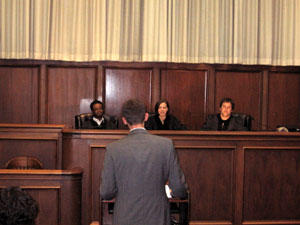All participants should appear in court on time and dressed in court attire. Below is a description of the basic procedure for oral argument.
Each team member should rise to state his/her appearance, as well as that of the team’s client. The first advocate for Petitioner may reserve up to two minutes of rebuttal time for him/herself or his/her partner. The advocate wishing to reserve time must do so by requesting the Court’s permission prior to presenting arguments. Only one person per team may use rebuttal time, and that individual must be prepared to argue and to answer questions related to both issues.
The first advocate to argue on behalf of the Petitioner should be prepared to state the facts of the case for the Court. The Court has the discretion to waive a recitation of the facts upon counsel’s request at commencement of the argument.
Each individual advocate will have 15 minutes to present arguments to the Court. Counsel for Petitioner will argue Issue #1, then Counsel for Respondent will argue issue #1, then counsel for Petitioner will argue Issue #2, and finally, Counsel for Respondent will argue Issue #2. If rebuttal time has been requested, rebuttal by Petitioner will follow. The bailiff will notify the advocates when there are five minutes, one minute, and no time remaining during argument. If time expires while a Justice is asking a question, additional time may be allowed at the discretion of the Justice posing the question. In any event, it is Counsel’s responsibility to state to the Court that time has expired, and request additional time to continue, if necessary.
Each team will argue one preliminary round “on brief” and one round “off brief”. “On brief” means a team will argue the position it advocated in its brief. This will be the position with which most participants are most familiar and comfortable. “Off brief” means that a team will argue the side it opposed in its brief. Prior to the beginning of the Oral Argument part of the competition, each team’s brief will be posted online for review by the other teams. These briefs will be instrumental in preparation for both the on brief and off brief rounds. Students often feel uneasy arguing off brief, but after completing the research and brief from one side, most competitors will have a more solid grasp of the arguments of the other side than they think they do. Therefore, although it is a challenge, arguing off brief is not as difficult as it appears, initially. More importantly, however, it keeps the competition interesting by adding variety to it.
After the preliminary rounds, eight teams will be chosen to move on to the quarter-finals. Only at the end of the preliminary rounds, and after the eight teams have been chosen, will the quarter-finalists be told whether they will argue on brief or off brief.
At the end of the quarter-finals, four teams will advance to the semi-finals. At that time, they will be notified whether they will argue on brief or off brief. The top two teams of the semi-finals will move on to the final round.